It would seem something simpler than automatic Windows recovery on a laptop? But not everyone uses this very convenient function. Because many laptop owners have never heard of it! We carefully study the instructions on sunscreen or insect repellent, but almost no one reads the instructions on their laptop! What is there that we don’t already know? Unfortunately, many are let down by such self-confidence. And I saw many users who paid money to the technician to reinstall the system. And it’s good if the master didn’t delete it hidden section during installation. But you can do this yourself, you just need to figure out automatic system recovery... and anyone can do it.
1. What is Windows automatic recovery and what is it for?
Now almost all laptop manufacturers have their own technology for restoring factory settings. For example, Acer's recovery technology is called eRecovery, Asus - AI Recovery, and so on. But the essence of the work is the same for everyone. All of them restore the system to a factory-like state, with all programs and drivers. And of course we are not talking only about the Windows operating system. To restore the system you need time BIOS boot press a specific button or key combination (more on this in point 2). A special wizard will launch where we only need to make a couple of clicks.
Acer eRecovery recovery utility menu (detailed instructions):
Laptop manufacturers care about us. And it's really very convenient function– no need to store disks with the operating system and drivers and bother installing them. All you need is to press a couple of buttons, and you have a system on your laptop in its original form!
2. How does automatic system recovery work?
There is one hidden partition (sometimes two) on the laptop hard drive. Several gigabytes in size. They contain a packed copy operating system, drivers and programs that unpack a copy of the operating system onto the system partition. These sections are hidden for us - the system sees them, but does not display them in Explorer.
When you press a key combination, it is not the operating system that loads, but programs that unpack copies of the system onto the system partition. A menu appears on the screen in which the user must select one of the proposed recovery options. It should be noted that During installation the contents are usually erased system partition
(drive C:\) and a new copy of the system is written.
It should also be noted that when installing the OS in the usual manner (from a CD), the boot area of the recovery system may be erased and in this case it will not work. Therefore, you should be careful, or make a backup copy of the MBR (boot area), and restore it if necessary. Backup MBR (and much more) can be done very simply using the utility Comodo Backup.
3. Hotkeys from popular laptop manufacturers.
Below is a list of hotkeys for calling automatic system recovery for different manufacturers laptops:
- Acer: Alt+F10(pre-login Laptop Bios, and enable the D2D Recovery function). The recovery system has a default password (000000 or AIM1R8).
- Asus: F9
- Dell Inspiron: Ctrl + F11
- Dell XPS: F8 or F9
- Fujitsu Siemens: F8
- HP: F10, F11
- Lenovo ThinkPad: F11
- LG: F11
- MSI: F3
- Packard Bell: F10
- RoverBook: Alt (press and hold)
- Samsung: F4
- Sony VAIO: F10
- Toshiba: F8, F11
So, the Windows automatic recovery feature on a laptop is a useful and very convenient feature that should not be neglected. If for some reason you deleted the hidden recovery partition, do not be upset. When installing the OS, simply enter the Product Key from the sticker on the bottom of the laptop. Or you can make your own hidden partition for automatic Windows recovery. But that's a completely different story)).
Instructions
Almost every laptop you can buy in a store computer equipment, comes bundled with the operating system. This has its advantages: you don’t have to spend money on buying an operating system, and there’s also no need to waste time installing the system. The presence of an operating system on the laptop’s hard drive indicates that HDD contains a hidden partition that is used to restore factory settings. Some users deliberately overwrite this partition to increase disk space; some are not even aware of the existence of this partition.
If you did not know about the existence of this hidden drive and want to use it for its intended purpose, you can use special keyboard shortcuts. To properly use the system recovery function and application programs, you need to know these keyboard shortcuts. The so-called hot keys must be pressed while the computer is booting, i.e. at the moment when the operating system crashes and cannot boot on its own. When you press the hotkeys, you will be taken to the factory reset menu.
Each laptop manufacturer has developed its own system for restoring settings; accordingly, the hot keys will differ. Below is a list of hotkeys from major laptop manufacturers:
Samsung - press F4;
Fujitsu Siemens - press F8;
Toshiba - press F8;
Asus - press F9;
Sony VAIO - press F10;
Packard Bell - press F10;
HP Pavilion - press F11;
LG - press F11;
Lenovo ThinkPad - press F11;
Acer - in BIOS, activate Disk-to-Disk (D2D) mode, then press Alt+F10;
Dell (Inspiron) - press Ctrl+F11
Laptop manufacturers assure that you will be able to restore the system, but the integrity of files or folders that are important to you is unlikely. Therefore, do not forget to frequently make copies of your files on removable media: CD/DVD drives, flash media, etc.
ASUS laptops have long been equipped with a convenient utility for resetting settings. This utility will help you return to factory state in just two simple steps. You need to read carefully, and the utility will do the rest, as I already wrote, for you.
To return your Asus laptop to factory settings, you must follow the following steps in sequence:
IN ASUS laptops function is enabled by default quick launch- Boot Booster. She bothers us. To disable it, go to the BIOS. On company laptops ASUS bios launched by pressing the F2 button while turning on the device. The button must be pressed before the operating system starts loading. It would be wise to press it several times to let the laptop know what we want from it.
Once in the BIOS, go to the Boot tab. You can go to the tab using the arrows on the keyboard or using the mouse, if the BIOS supports it. In the Boot tab, you need to find the Boot Booster item, highlight it and press Enter. After pressing Enter, a window will open in which you need to select the Disabled item. In this way we will disable the quick start system, which will give us the opportunity to return to factory settings.
Now, use the arrow keys on your keyboard to go to last tab and select Savechangesandexit and wait for it to activate. This will save your work in the BIOS and restart your laptop.
The recovery program will prepare everything necessary files, will ask you again and begin system recovery. After this, system preparation for data recovery will begin. A message will appear on the screen indicating that all user settings will be deleted. You will need to confirm this action by clicking OK. Your further participation is not required. During the process, the laptop will reboot several times. Approximate waiting time is 30 minutes.
Hello admin, I want to restore the factory settings on my HP laptop, I launched the HP Recovery Manager program and it offers 8 recovery options! How do I choose the right one? There are two partitions on my hard drive: (C:) and (D:).
Us:) Windows 8.1 installed.
On (D:) There is a collection of films and music.
Tell me, when restoring from a laptop, will all files be deleted or only information from the disk (C:)?There is no way for me to lose those files that are on the disk (D:), and there is simply nowhere to copy them, portable hard drive No USB. If you have a detailed article for me, I would be grateful.
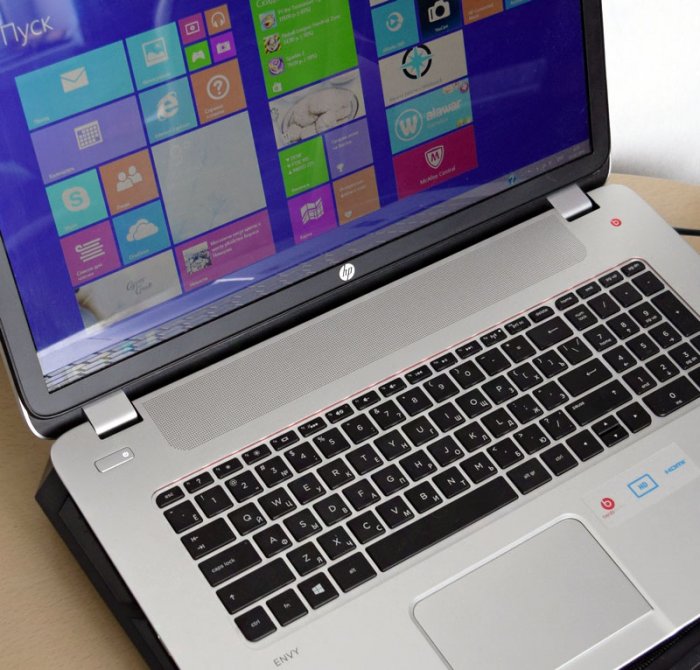
Friends, if the operating system installed on your laptop has become mischievous, then you don’t have to bother searching for various viruses, crooked programs, incorrect drivers and other reasons that led to unstable Windows work, take it and simply restore the factory settings on your laptop! You can do this on an HP (Hewlett-Packard) computer in 20 minutes. The operating system will be in perfect condition at the time of purchase, all that remains is to install the software and that’s it. A rollback to the original state will only affect the drive (C:), information on other drives will remain untouched.
The program is responsible for recovery on HP laptops HP Recovery Manager, which can be launched even if the computer device does not boot. In my article I want to show you all the ways to restore an HP laptop to “store settings”.
First way. Go to the Metro Windows 8.1 interface, find among the applications " HP Recovery Manager" and launch it. Click on the "Windows Recovery Environment" button. Restart your computer and enter the Windows Recovery Environment to update the image or restore the system to initial settings manufacturer."
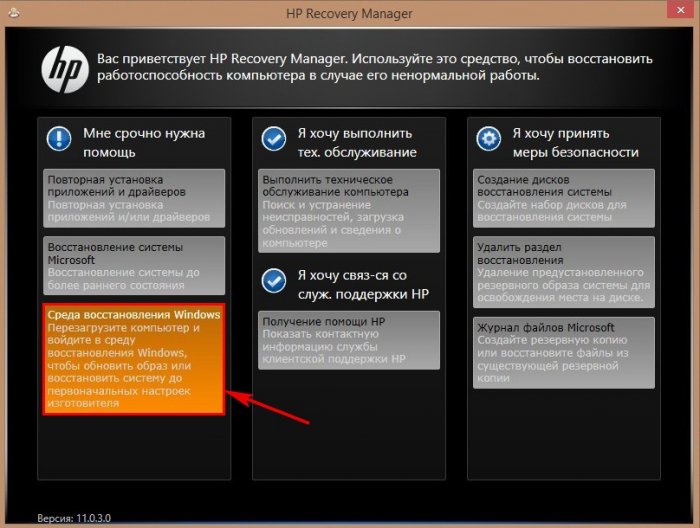
Click OK. Laptop reboots
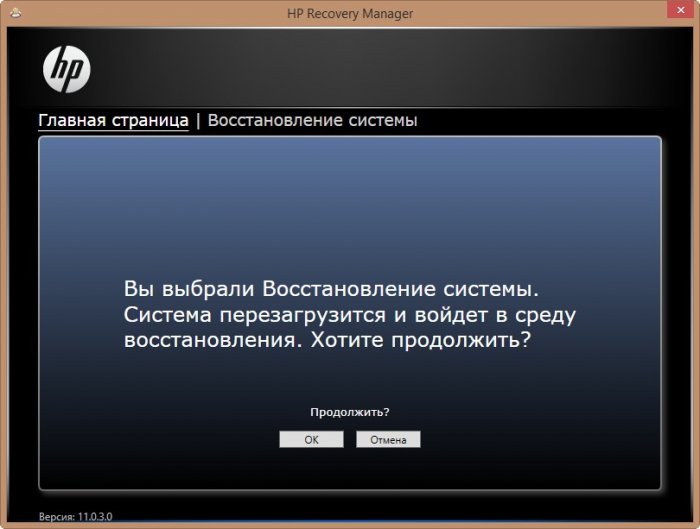
Click Diagnostics.
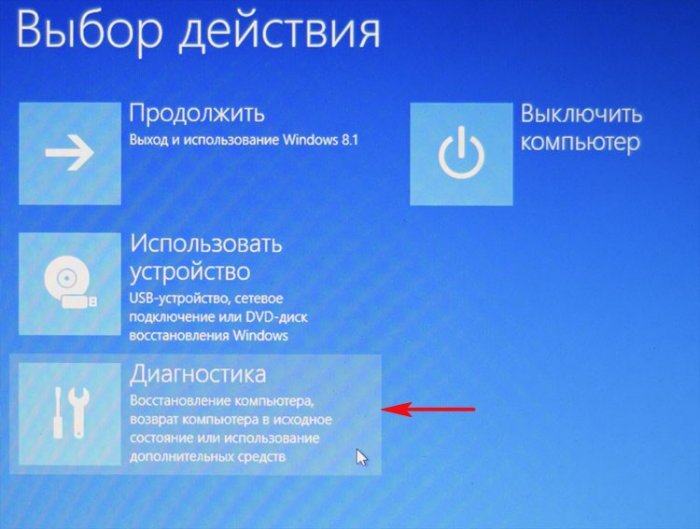
Recovery Manager
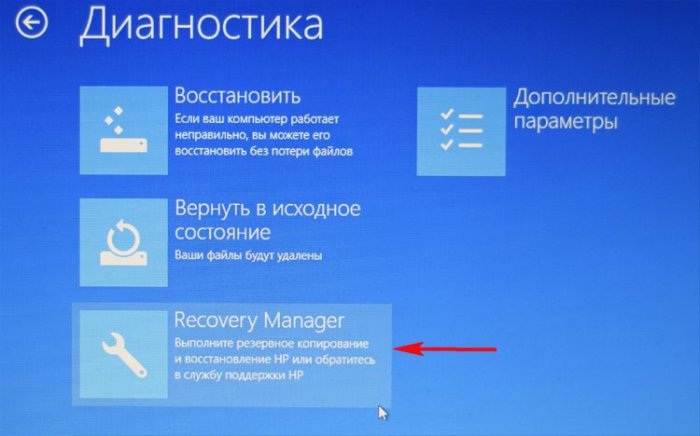
Click on the button Restoring the system to its original condition when shipped from the manufacturer.
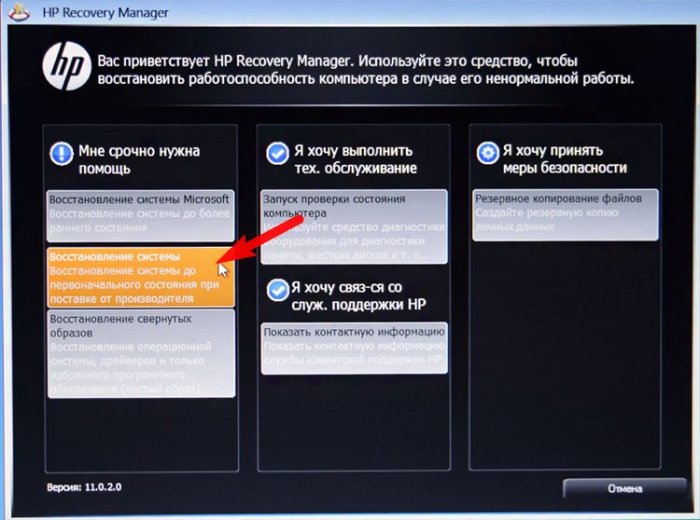
Mark the item. Further.
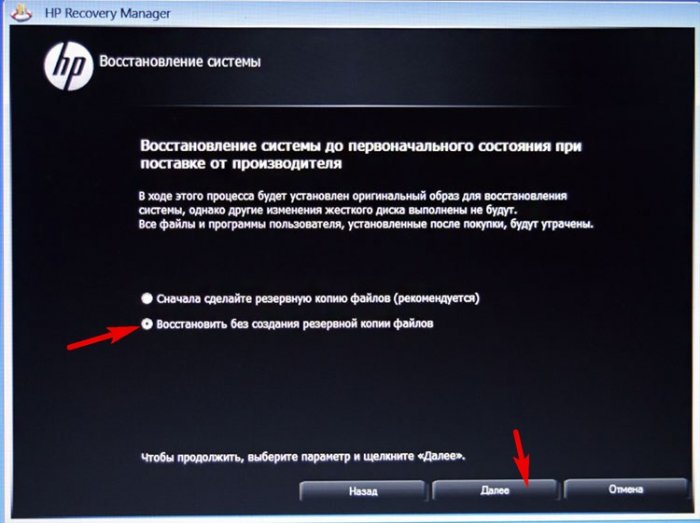
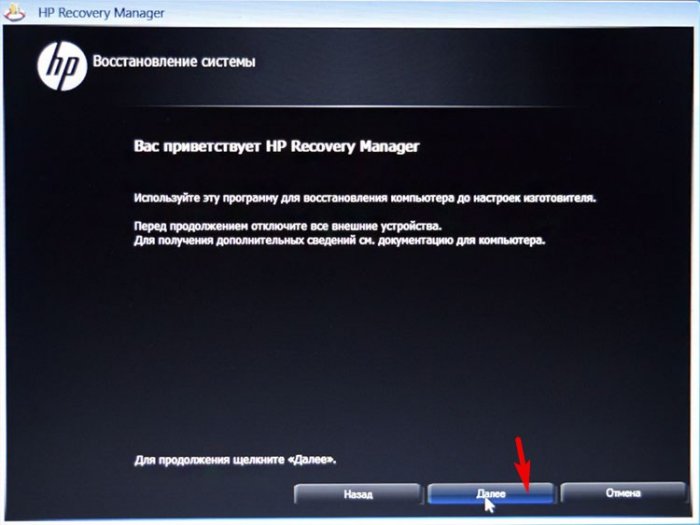
The process of returning the laptop to its original settings begins.
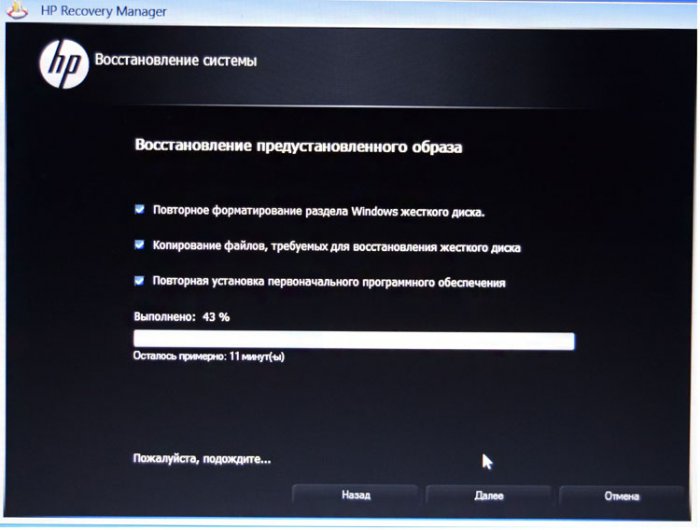
Click Finish.
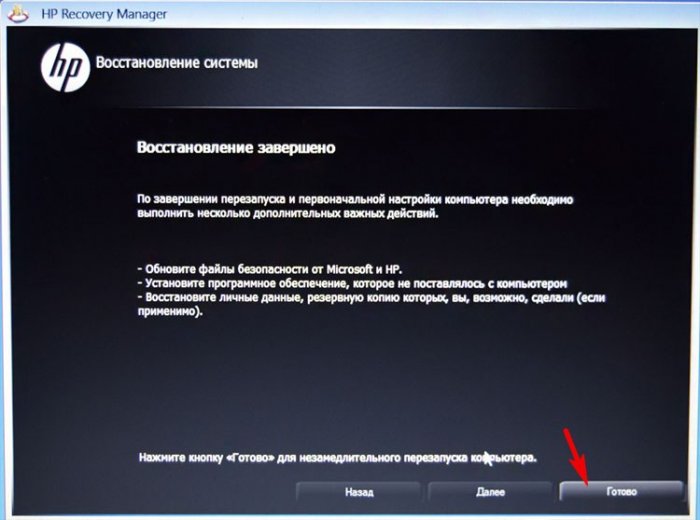

All we have to do is configure our personal settings and get started.
Regional settings are usually configured correctly. Further
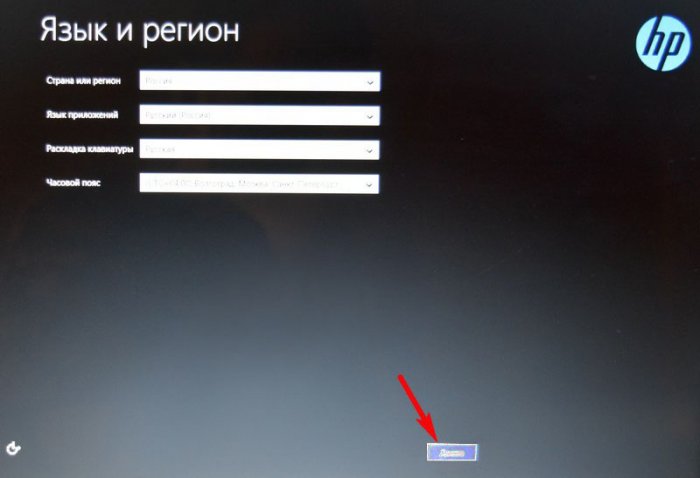
I accept
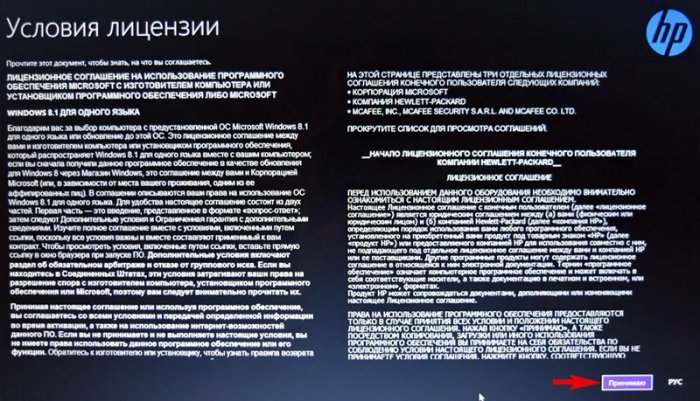
Skip
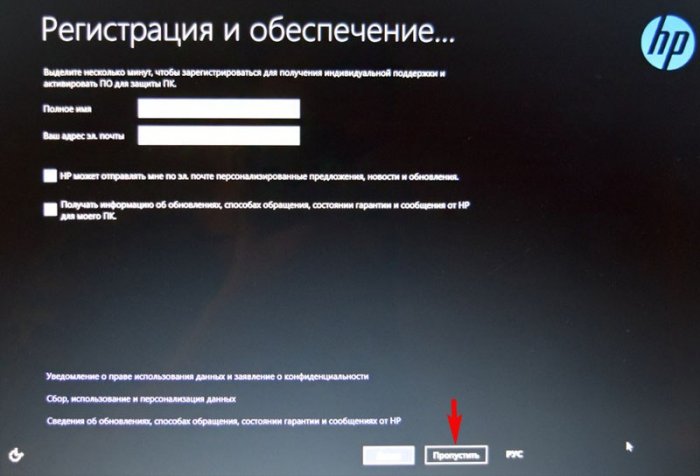
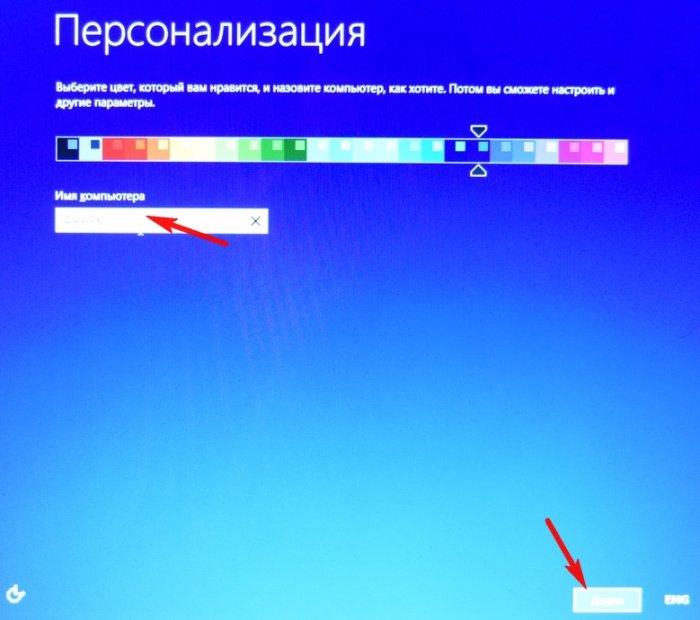
Skip this step
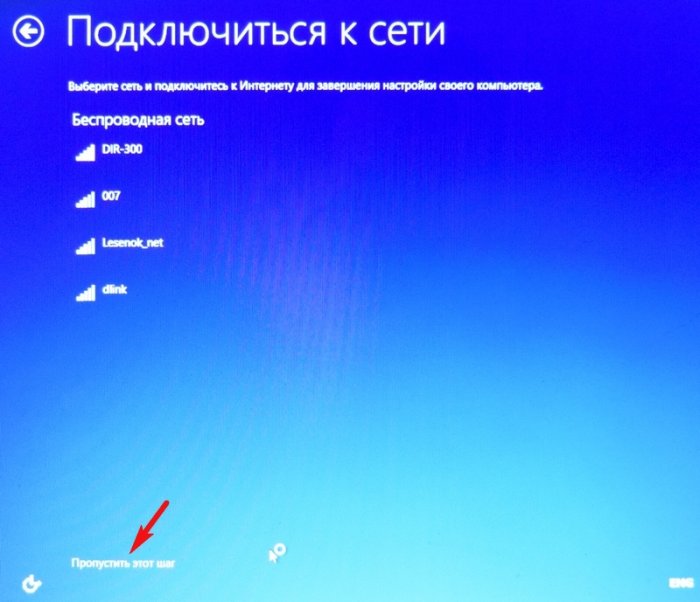
Use standard settings
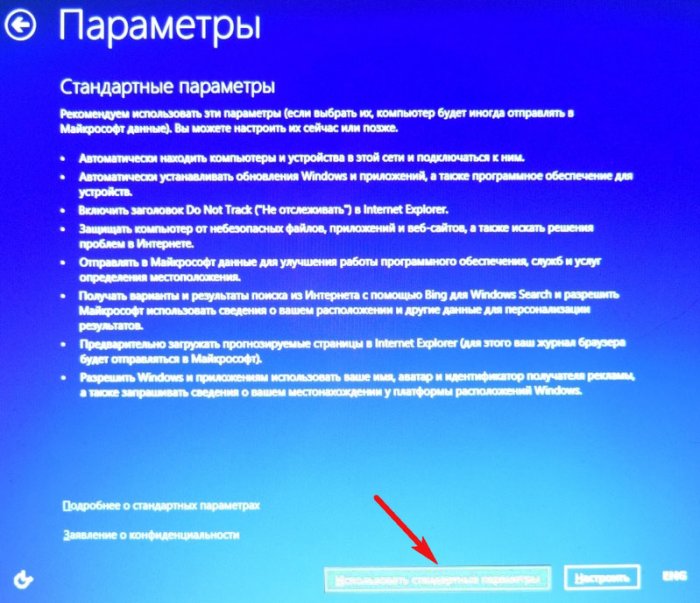
Enter your username and click Finish.
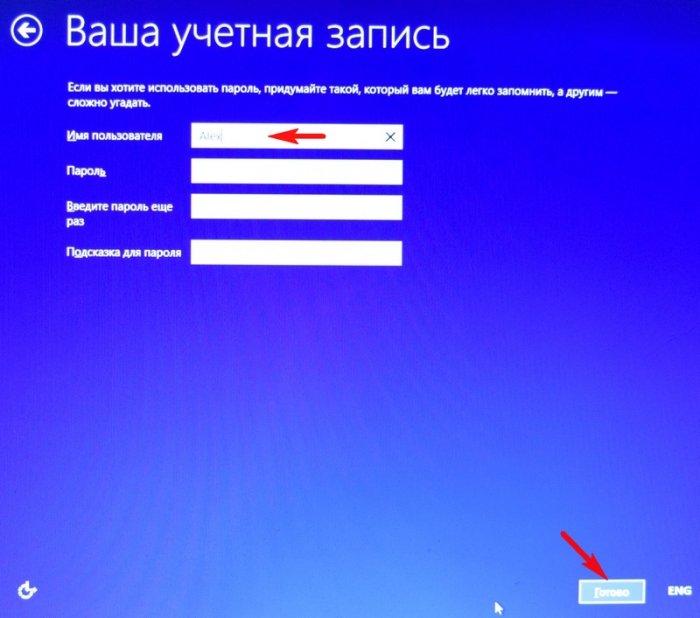
Loading clean Windows 8.1. The recovery affected only the drive (C:), all files on other drives remained intact.

How to restore to factory settings HP laptop if it won't boot
This can happen due to various system errors or destructive actions malware and in this case you will not be able to get to the Metro interface and launch HP Recovery Manager, but you can still start the rollback process.
Press the button when booting the laptop Esc and enter the settings menu. To enter recovery mode, press the key F11.
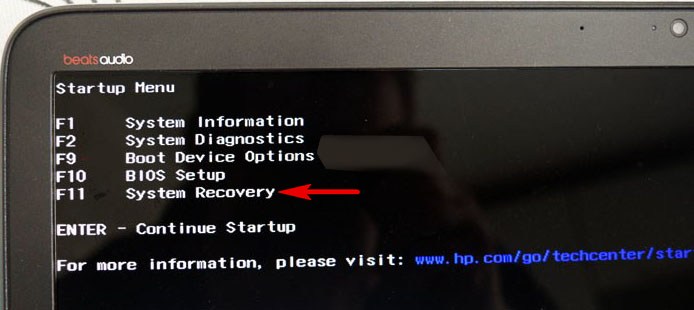
The already familiar “Select Action” menu.
Select the Diagnostics option.

Recovery Manager

Click on Restore the system to its original condition as shipped from the manufacturer. Then you already know how to act.

How to restore to factory settingsHP laptop if it won't boot and hidden partitions with factory settings are deleted
If you reinstalled Windows 8.1 on Windows 7 on your laptop, then you probably deleted everything before installing the seven partitions on the hard drive, including a hidden partition with the factory image. In this case, you need to use . These discs need to be made in advance.
Insert the recovery disk into the laptop drive.
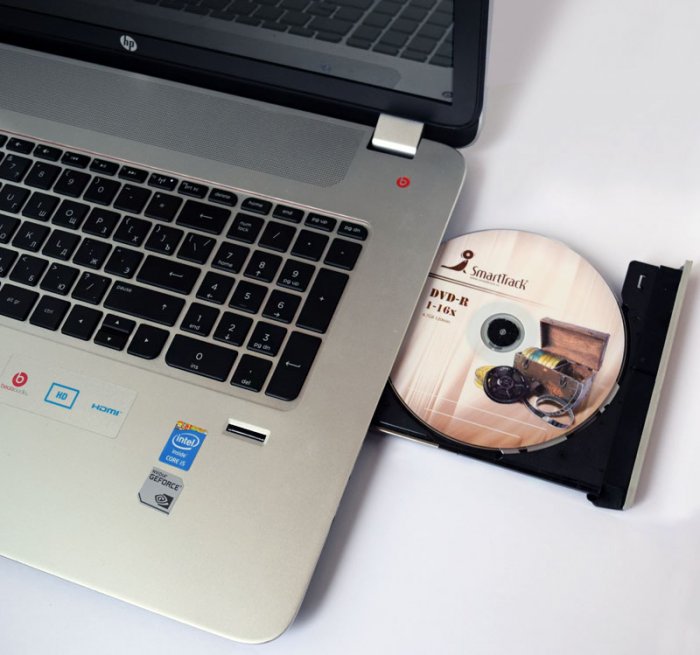
Press the button when booting the laptop Esc and enter the settings menu. To boot the laptop from the recovery disk, press the key F9.
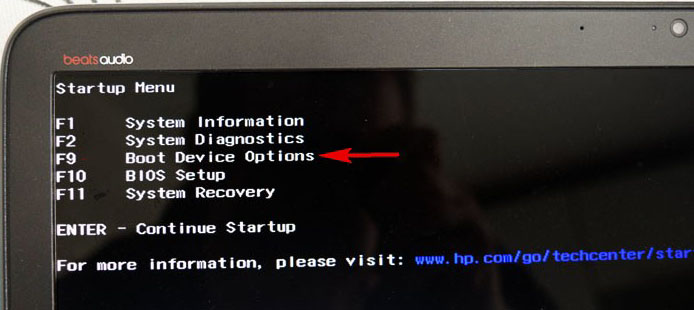
Select in boot menu drive and press Enter.
![]()
Mark the item Run the program from the media
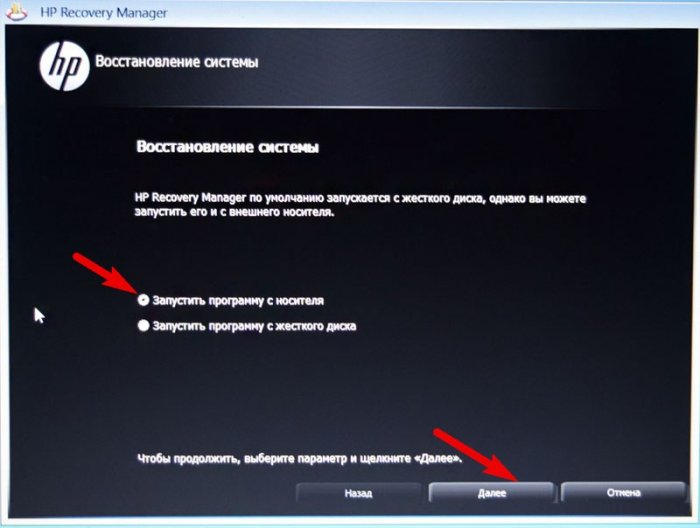
Factory reset
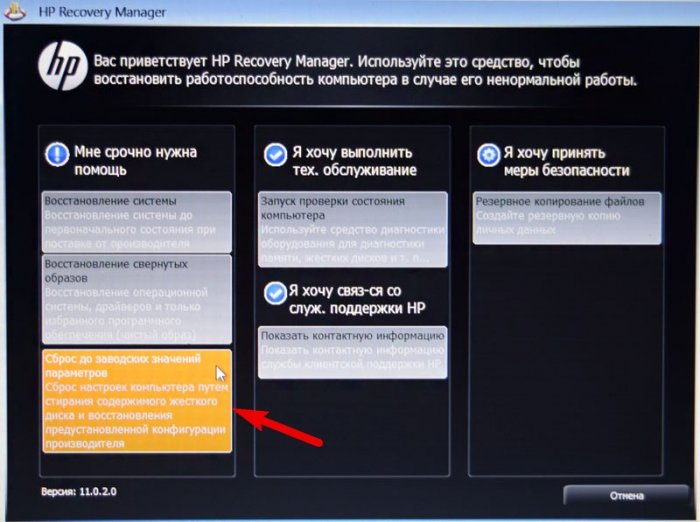
Mark the item Recover without creation backup copy files. Further.

The process of returning the laptop to the initial state, which is sure to end successfully.
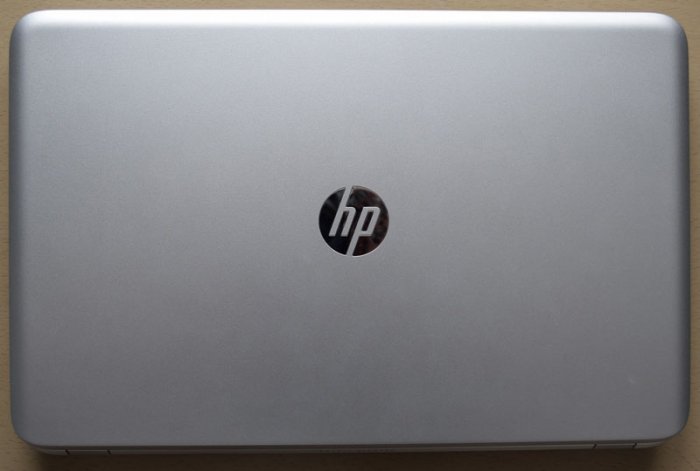
Articles on this topic:
If Windows stops loading, then to restore correct operation you can use standard utilities.
One of the main nightmares of computer lovers is to encounter a situation where they cannot turn on the device. The operating system starts to load, but eventually displays a message like: “Failed to configure Windows updates, changes are being undone, do not turn off the computer." After which nothing new happens - recover software It doesn’t work, and downloading stubbornly doesn’t help.
Viruses and all kinds spyware- the most common causes of PC problems. Let's figure out how to defend ourselves.
System recovery tools
Before the release of Windows 7, this situation turned into numerous dances with a tambourine, and often even complete reinstallation operating system. Now everything is different, and often the problem is solved with standard tools from Microsoft, which do not even need to be specially installed. The task comes down to being aware, in principle, that such a toolkit exists, as well as simply remembering it when something “irreparable” suddenly happens.
The trick is that when you boot your computer, before the icons appear Windows boot, have time to get into the advanced parameters of this very boot, where you will be able to run diagnostics and, if necessary, restore the system to the selected checkpoint. Windows 7 required you to press a function key when booting F8, and then select the “Troubleshoot” option (although in rare cases the “Last Known Known Configuration” option saved the day).
More Windows 7 download options
Once in the “System Recovery Options” menu, in most cases one of the first two options became a salvation. "Startup Recovery" could save the operating system automatic mode, A "System Restore" required you to manually select a checkpoint to which to rollback.
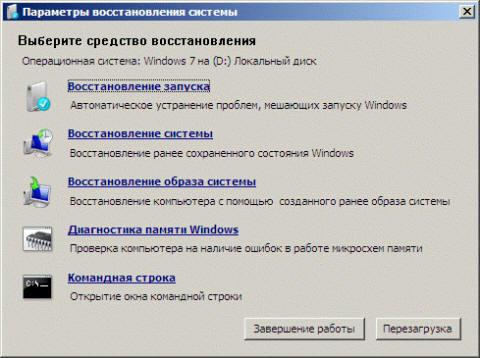
Recovery options Windows systems 7
In order to be able to restore it to its original state in the event of a malfunction of the operating system, it is necessary to make a recovery disk in advance. Microsoft would be betraying itself if, with the update of its brainchild, it left all the useful tools as before. Windows 10 system recovery is carried out by pressing hot keys Shift+F8, and, unlike “seven”, you need to press this combination very, very quickly, since the operating system itself began to load much faster.
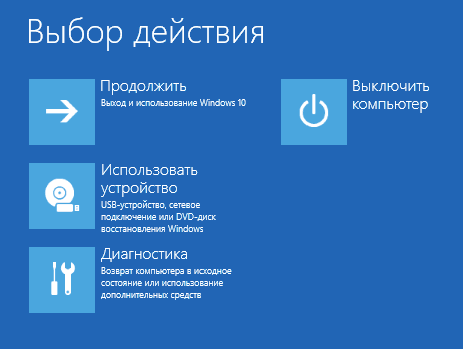
Has undergone changes and appearance saving menu. By selecting “Diagnostics”, in “ Additional options“There are the already familiar “System Restore” and “Startup Repair” (only in a different order). There is also an option “Return to the previous build” if you updated to “ten” from one of previous versions Windows.

If automatic recovery doesn't work
Restoring a Windows system to one of the previous checkpoints is not a difficult task. It is only important that these points themselves exist in the system, because sometimes users themselves manually disable their creation, at the same time deleting existing ones. It really makes sense to periodically clear old control points, since they take up a lot of space. But giving up recovery points altogether is a risky proposition.
How to navigate the Internet without picking up viruses? Secure DNS servers will help. To make sure that restore points are automatically created for you or to make changes to the corresponding settings, you need to select the display of Large icons (or Small icons, but not Categories) in the “Options” window and select the “Recovery” option. There's already a choice "Setting up system recovery", check whether the protection is enabled and, if necessary, use the “Configure” button. Here you can manually create a point for subsequent recovery.
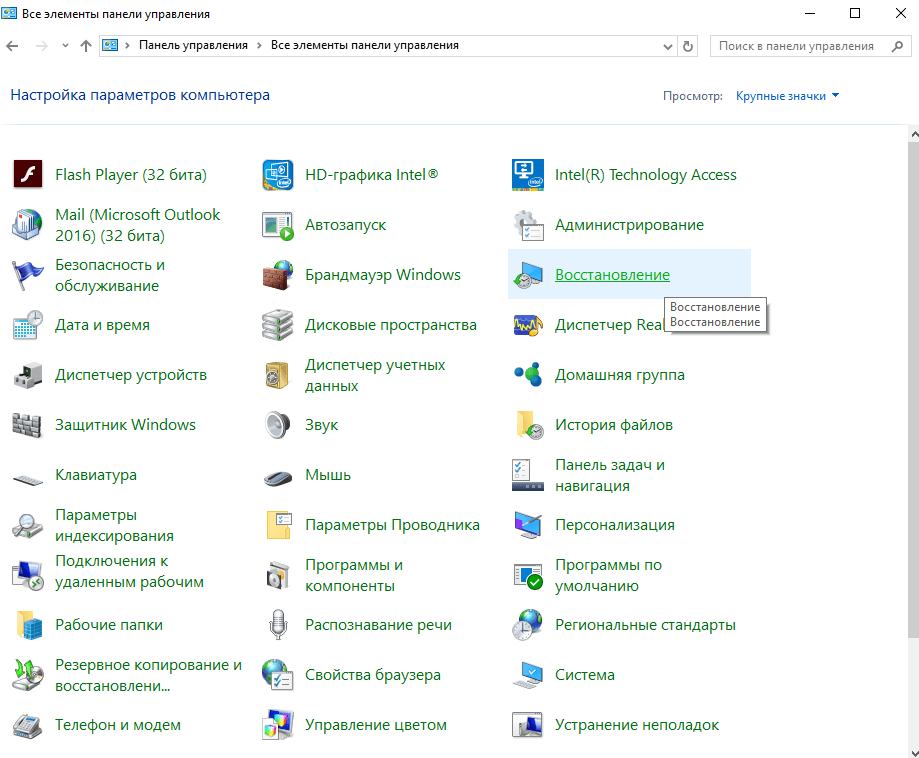
Recovery Windows computer 10
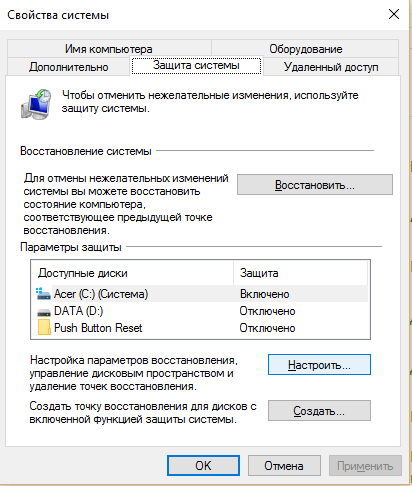
Windows 10 restore points
If we have recovery points, then using the method described earlier, that is, using the built-in Windows tools To restore the system, you can quickly roll back to an earlier state of the computer without losing important files.

Creating a Windows 10 recovery image
In extreme cases, you will have to restore the system to its original state or to a previously created system image. It is advisable to create a “System Image” and a “System Repair Disk” in a working state of the operating system, after you have installed all the applications you need. This is all done through the same “Control Panel” (aka “Settings”), when viewing by “Categories”, selecting “Backup and Restore (Windows 7)”. Here you can restore the operating system to a previously created image if the computer still boots, but has no longer worked as it should.
With every operating system release Microsoft company requests more and more information from users. But you can moderate her appetites.
Restoring a laptop to factory settings
If standard means do not help, and you do not have a disk or USB device with a recovery image, then laptop owners can use “hot keys” to launch the built-in recovery utility. Some models may even have a separate key for these purposes, for example, OneKey Recovery from Lenovo, but this is rather an exception. In other cases, it is important to know which one " hotkey» for your laptop, since it tends to differ among manufacturers.
Hotkeys for laptop manufacturers:
F3– MSI;
F4– Samsung;
F8– Fujitsu Siemens;
F8- Toshiba;
F9- ASUS;
F10- Sony VAIO;
F10- Packard Bell;
F11- HP Pavilion;
F11- LG;
F11- Lenovo ThinkPad;
Alt+F10- Acer (before this, select Disk-to-Disk (D2D) in the BIOS);
Ctrl+F11- Dell Inspiron;
Hold [ Alt] - Rover.
Factory Utility will restore the device to its original condition, as if it had just come from the store. This will delete all programs with settings, all files, including favorite photos, which it makes sense to store in just such cases. cloud services. However, the device will be able to work again, and in some cases this method will simply help prepare the laptop for subsequent resale or transfer to relatives.
Hi all. This article will describe a method for system recovery (in my Windows case 7 x64 home edition) from the recovery section on hp laptops, more specifically on the hp pavilion dv6 6169. I’m writing about this because I couldn’t find such instructions on the Internet.
The background is simple: the licensed Win 7 installed on the laptop began to work extremely poorly. There was no disc with drivers and system included with the laptop. The fight against the OS by formatting drive C is over. Install pirated version I had no desire, I wanted to return the licensed one in its original form.
Anyone is suitable for restoration boot disk with the pre-installed Acronis disk director program (I used the Windows 7 Rose SG build from ChipXp.ru).
1. Any data from drive C will be deleted, you are aware.
2. When the system boots, go into the BIOS and change the boot priority from HDD to CD-rom
3. Boot from the disk, run Acronis disk director
4. Finding the partition Recovery, most likely it is hidden
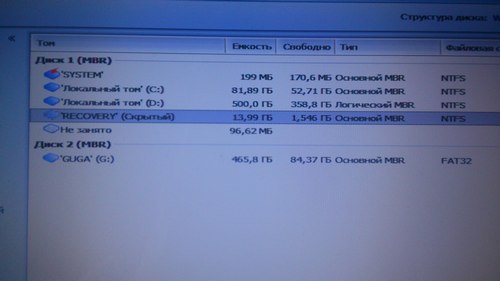
5. Right-click on it and select “Mark as active”
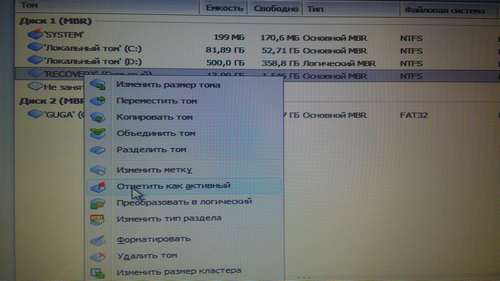
6. In the warning that appears, click on OK.
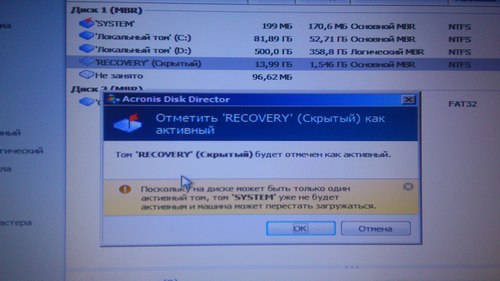
7. After this, we make the changes, go to reboot, go back to the BIOS, change the priority to HDD, reboot the laptop again, after which recovery will begin from the Recovery partition. In the end I got a fresh one licensed Windows 7 s installed drivers. Ready.
I came across a lot of not very good ones on the net. simple ways restoring the OS without a disk on a laptop, but I have never seen this anywhere, although it is very simple.
Restoring the system from the recovery partition on hp pavilion laptops
Post navigation
Please help, I’ve already tried everything, the recovery partition itself was not hidden from the beginning, I tried acronis but to no avail. The partition is not hidden, when you press F11 it swears and does not boot into recovery. Any idea what I should do?
For those who have a flash drive/disk installed in their main drives.
(i.e. there is no function to mark as active because active is your boot disk/flash drive).
At the bottom, select the desired volume, in this case the volume in which we have Recovery, and on the right select Convert to “physical” (I don’t remember exactly, well, there are few options there).
After this, you can mark Recovery as active.
I got to this point, as always, by trial and error :)
To restore your system from the recovery partition, follow the steps below:
actions.
1. Launch HP Recovery Manager using one of the following methods.
● Select Start > All Programs > Security > HP Recovery Manager > HP
Recovery Manager.
● Turn on or restart your computer and press the esc key when at the bottom
The message “Press the ESC key for Startup Menu” will appear on the screen.
ESC to go to the start menu) . When the message “F11
(System Recovery)" (F11 (System Recovery)) press the f11 key.
2. Click System Recovery in the HP Recovery window
3. Follow the instructions on the screen.




